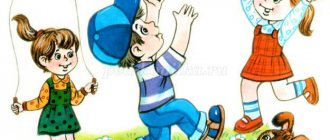Norms of speech development at the age of 4-5 years
In order to timely identify problems with speech development, it is necessary to navigate what the baby should be able to do, and only after that “sound the alarm” by turning to speech therapists and speech pathologists. According to the norms of speech development for children from 4 to 5 years old, at this age a child should be able to:
- speak in such a way that everyone around you understands him, not just those closest to you;
- calmly operate with your vocabulary (minimum 3000 words); build logical sentences from 6-8 phrases;
- understand the difference between people, animals and inanimate objects, know their characteristics and distinctive features (animals cannot speak, a dog has four legs, a cat meows, etc.);
- be able to find an object, focusing only on its description (for example, a ball - round, blue, bouncy) and create descriptions of objects yourself;
- understand the meaning of prepositions and insert them correctly into sentences;
- have an understanding of different professions, who does what (teacher - teaches children, pastry chef - bakes cakes, etc.);
- be able to maintain a conversation on topics that he understands, ask relevant questions and answer questions put to him;
- retell heard stories, fairy tales, and entertaining stories without difficulty;
- know by heart simple rhymes, nursery rhymes, tongue twisters for children; state your first and last name without prompting, know your age and residential address;
- be able to answer questions about your pastime (where you were, what you ate for breakfast, who you met on the way to kindergarten, etc.).
Diagnostics of ZZR
Diagnosis of mental disorders includes checking the following indicators: pronunciation of sounds;
- sound-syllable structure of the word;
- phonetic sensitivity;
- possibilities of phonemic analysis of synthesis;
- the state of vocabulary and grammatical structure of impressive, expressive and coherent speech.
Based on the test data, the speech therapist draws up a diagnostic card describing the features of the child’s speech development, on the basis of which a conclusion is made and recommendations are made regarding speech development classes.
Didactic games
Didactic games for speech development for children 4-5 years old are varied, let’s look at the most popular ones.
- Find the mistake
This game allows you to correctly pronounce and remember words that have many words, and also actively develop auditory attention. For example, a child is shown a card of a baby elephant and told: he has a trunk (true), he runs fast (not true), he is heavy (true). In addition to the characteristics mentioned above, the child is asked to name a few more.
- That may or may not be the case
Thanks to this game, children learn to notice inconsistencies and actively develop their logical thinking. In individual sentences or short stories, it is necessary to identify what cannot be. For example: “Autumn has come and the first green leaves have begun to appear on the trees.”
- What season
Through poetry and descriptive stories, one can learn to identify the seasons very easily.
- Which, which, which
For a word that an adult asks for, it is necessary to choose the correct definition. For example: “The sun is yellow, hot, round”, “Snow is white, wet, cold”, “The hat is new, blue, warm.”
- Guess the plant
Independently describing objects and guessing what is described by an adult allows you to develop attention and memory, learn to correctly describe objects and guess them based on their characteristics.
- What happens
The child is asked to tell what could be, for example, blue - the sky, sea, mother's eyes, or tall - a fence, a house, a tree. Such activities help not only to develop attention, but also to develop the ability to classify objects according to different criteria: shape, color, etc.
- When does this happen
The child is presented with pictures that depict different actions (for example, it is snowing). It is necessary to determine when this happens (the correct answer is in winter).
Most didactic games are used by kindergarten teachers in accordance with the current Federal State Educational Standards, which are aimed at the active development of speech in preschool children. A complete list of all kinds of didactic games and various exercises (with detailed instructions) can be found in Programs for the development of speech and cognitive abilities for children 4-5 years old by different authors (Karpova S.I., Mamaeva V.V., Ushakova O.S.).
S.I. Karpova V.V. Mamaeva Development of speech and cognitive abilities of preschoolers 4-5 years old
Ushakova O.S. Speech development program for preschool children
Exercises and tasks
The main exercises and tasks that need to be done daily at home for the active development of coherent speech are:
Articulation gymnastics
- Eat some jam. You need to imagine that after eating the pie there is jam left on your lips that needs to be licked. Using your tongue, smoothly lick the jam from the lower and upper lips.
- Spade tongue. It is necessary to imagine that the tongue is a shovel, which should lie on the stand (lower lip) for as long as possible. We extend the tongue, placing it on the lower lip, and hold it in this position for 10-15 seconds.
- The tongue is a needle. You need to imagine that the tongue is a thin needle that needs to be held in place. We stretch out our tongue, trying to make it narrow, and try to hold it for 10-15 seconds.
- I'm a horse. The child needs to imagine himself as a horse that clatters its hoofs and clicks its tongue. We stomp our right and left feet in turn, clicking our tongue as we do so.
These exercises are best done for no more than 5-7 minutes and repeated 2 times a day.
It’s more fun to do articulation gymnastics with children by looking at pictures and reading rhymes.
Finger games
- Kitty. Both palms are clenched into fists and lie on a flat surface. It is necessary to simultaneously straighten the fingers on both handles, pressing them tightly to the table. The exercise must be repeated 4-5 times. After several lessons, the task can be complicated: first, the fingers on one hand are straightened, then they are compressed, and on the second they are straightened.
- Let's treat the cat with milk. Palms as if scooping out milk.
- Bunny. The fingers imitate the ears of a bunny, the fingers run along the table, clenched into a fist, fist in fist.
- Dog. The index finger shows the tail of the dog, the fingers are clenched into a fist, the thumb is raised up, the fingers run away.
Using finger games with parallel learning of rhymes can show quite good results, since there is a strong relationship between the human hand and the speech center of the brain. The baby easily and more emotionally perceives information and reproduces it in the future without problems.
Logorhythmics
Logorhythmics is the simultaneous reading of poetry, accompanied by a certain set of movements against the background of thematic music. Initially, the adult shows everything by example, after which the child is asked to repeat what he just saw.
The optimal time to complete this task is the second half of the day, the regularity of classes is every 1-2 days.
A special place in speech development classes is given to cartoons, which children love so much. There are specially designed cartoons aimed at reinforcing the letters of the alphabet, learning colors, learning to count and speech development.
The choice of cartoons remains up to the parents, but a prerequisite is its versatility (for both boys and girls), the presence of positive characters, and high quality video and sound.
Tongue Twisters
Tongue twisters for children are small rhyming phrases, often with a specific plot. Thanks to classes on tongue twisters, speech clarity is effectively developed and vocabulary is replenished. There are the following types of tongue twisters that are used during speech development classes:
- Containing the sound [L]: “The Christmas tree has needles, needles and pins at the Christmas tree,” etc.
- Containing sounds [Z], [Zh], [S], [Sh]: “Six mice in the reeds, ShurShat”, etc.
- Containing the sound [P]: “The beavers are going to the cheese forests. Beavers are kind, beavers are good”, etc.
- Containing the sounds [З] и [Зь]: “Zoya’s Bunny is called ZaZnayka”, etc.
Properly selected tongue twisters for speech development, provided regular practice, can significantly improve diction and develop competent speech.
If you do not approach the problem of children's speech development in a timely manner and with all seriousness, then in the near future they may have difficulties in learning at school and in communicating with classmates (due to incorrect pronunciation of sounds). This is fraught with ridicule, a decrease in the child’s self-esteem, and the disappearance of the desire to learn and communicate with others. Therefore, the development of speech in children aged 4-5 years should become a priority task for parents themselves, who can actively work with their children at home, in a playful way.







